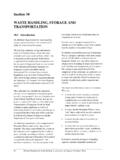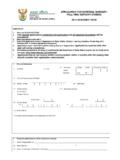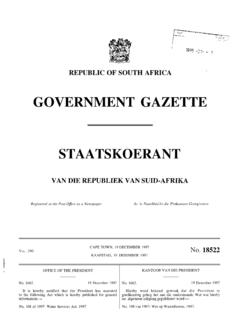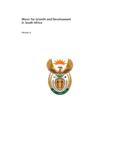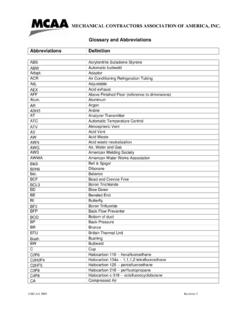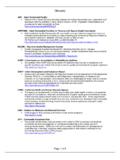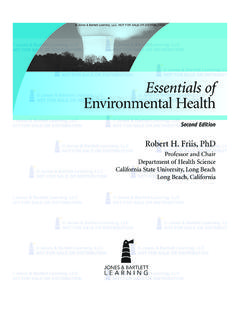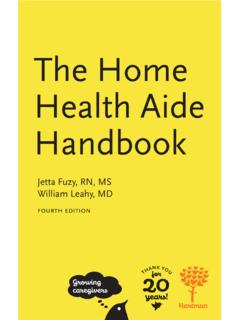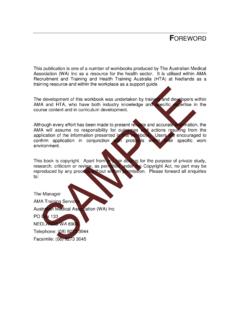Transcription of SOUTH AFRICAN WATER QUALITY GUIDELINES
1 SOUTH AFRICAN WATER QUALITY GUIDELINES . Volume 1: Domestic WATER Use Second Edition, 1996. I would like to receive future versions of this document (Please supply the information required below in block letters and mail to the given address). Name:.. Organisation:.. Address:.. Postal Code:.. Telephone No.:.. E-Mail:.. Mail reply to: Director: WATER QUALITY Management Department of WATER Affairs & Forestry Private Bag X313. PRETORIA. 0001. SOUTH AFRICA. SOUTH AFRICAN WATER QUALITY GUIDELINES Volume 1. Domestic Use Department of WATER Affairs and Forestry Second edition 1996. Published by Department of WATER Affairs and Forestry Private Bag X313.
2 PRETORIA. 0001. Republic of SOUTH Africa Tel: (012) 299-9111. Printed and bound by The Government Printer, Pretoria ISBN 0-7988-5338-7 (Set). ISBN 0-7988-5339-5 (Volume 1). Copyright reserved No part of this publication may be reproduced in any manner without full acknowledgement of the source This report should be cited as: Department of WATER Affairs and Forestry, 1996. SOUTH AFRICAN WATER QUALITY GUIDELINES (second edition). Volume 1: Domestic Use. Edited by S Holmes, CSIR Environmental Services Produced by: CSIR Environmental Services P O Box 395. PRETORIA. 0001. Republic of SOUTH Africa This volume is the first in a series of eight volumes comprising the SOUTH AFRICAN WATER QUALITY GUIDELINES .
3 Volume 1: SOUTH AFRICAN WATER QUALITY GUIDELINES - Domestic WATER Use Volume 2: SOUTH AFRICAN WATER QUALITY GUIDELINES - Recreational WATER Use Volume 3: SOUTH AFRICAN WATER QUALITY GUIDELINES - Industrial WATER Use Volume 4: SOUTH AFRICAN WATER QUALITY GUIDELINES - Agricultural WATER Use: Irrigation Volume 5: SOUTH AFRICAN WATER QUALITY GUIDELINES - Agricultural WATER Use: Livestock Watering Volume 6: SOUTH AFRICAN WATER QUALITY GUIDELINES - Agricultural WATER Use: Aquaculture Volume 7: SOUTH AFRICAN WATER QUALITY GUIDELINES - Aquatic Ecosystems Volume 8: SOUTH AFRICAN WATER QUALITY GUIDELINES - Field Guide Foreword The Department of WATER Affairs and Forestry is the custodian of SOUTH Africa's WATER resources.
4 Part of its mission is to ensure that the QUALITY of WATER resources remains fit for recognised WATER uses and that the viability of aquatic ecosystems are maintained and protected. These goals are achieved through complex WATER QUALITY management systems which involve role players from several tiers of government, from the private sector and from civil society. A common basis from which to derive WATER QUALITY objectives is an essential requirement that enables all role players involved in such a complex system to act in harmony in order to achieve the overarching goal of maintaining the fitness of WATER for specific uses and to protect the health of aquatic ecosystems.
5 For these reasons the Department initiated the development of the SOUTH AFRICAN WATER QUALITY GUIDELINES , of which this is the second edition. The SOUTH AFRICAN WATER QUALITY GUIDELINES serve as the primary source of information for determining the WATER QUALITY requirements of different WATER uses and for the protection and maintenance of the health of aquatic ecosystems. The process that followed and the wide variety of organizations and individuals involved in the development of these GUIDELINES ensured the acceptance and use of these GUIDELINES by all significant role players, as the SOUTH AFRICAN WATER QUALITY GUIDELINES .
6 These GUIDELINES are technical documents aimed at users with a basic level of expertise concerning WATER QUALITY management. However, the role players involved in the different WATER use sectors are expected to use these GUIDELINES as a basis for developing material to inform WATER users in specific sectors about WATER QUALITY and to empower them to effectively participate in processes aimed at determining and meeting their WATER QUALITY requirements. The Department recognises that WATER QUALITY GUIDELINES are not static and will therefore update and modify the GUIDELINES on a regular basis, as determined by ongoing research and review of local and international information on the effects of WATER QUALITY on WATER uses and aquatic ecosystems.
7 The process of developing WATER QUALITY GUIDELINES , and the involvement of key role players, is a contining one. The second edition is published in a loose leaf, ring binder format to facilitate the regular updating of the GUIDELINES . All those who want to comment on and make suggestions concerning the SOUTH AFRICAN WATER QUALITY GUIDELINES are invited to do so at any time by contacting the Director: WATER QUALITY Management, Department of WATER Affairs and Forestry, Private Bag X313, Pretoria 0001. Finally I wish to express my sincere appreciation to all those who have been involved in the development of these GUIDELINES .
8 I also look forward to their continued involvement in maintaining one of the corner- stones of the WATER QUALITY management system in SOUTH Africa. Professor Kader Asmal MP. Minister Of WATER Affairs and Forestry May 1996. ii ii Contents Page Introduction .. 1. Approach to Guideline Development .. 7. Characterisation of Domestic WATER Use .. 11. Information Contained in the GUIDELINES .. 13. Algae .. 17. Aluminium .. 23. Ammonia .. 27. Arsenic .. 31. Asbestos .. 35. Atrazine .. 37. Cadmium .. 39. Calcium .. 43. Chloride .. 47. Chromium(VI) .. 51. Colour .. 55. Copper .. 57. Corrosion .. 61.
9 Dissolved Organic Carbon .. 67. Fluoride .. 71. Indicator Organisms .. 77. Indicator Organisms .. 83. Heterotrophic Bacteria .. 83. Total Coliforms .. 85. Faecal Coliforms .. 87. Coliphages .. 89. iv Enteric Viruses .. 93. Protozoan Parasites .. 97. Iron .. 101. Lead .. 105. Magnesium .. 109. Manganese .. 113. Mercury .. 117. Nitrate .. 121. Odour .. 125. pH .. 129. Phenols .. 133. Potassium .. 137. Radioactivity .. 141. Selenium .. 149. Settleable Matter .. 153. Sodium .. 155. Sulphate .. 159. Trihalomethanes .. 163. Total Dissolved Solids .. 167. Total Hardness .. 173. Turbidity .. 177. Vanadium.
10 181. Zinc .. 185. Glossaries .. 189. Glossary of terminology .. 189. Glossary of abbreviations / acronyms .. 195. Glossary of units of measure .. 197. iv Acknowledgements The following persons and organisations are thanked for their contributions to these GUIDELINES . EXECUTIVE COMMITTEE. Ms T Belcher, Department of WATER Affairs and Forestry Dr D C Grobler, CSIR Environmental Services Dr S Holmes, CSIR Environmental Services Mr J L J van der Westhuizen, Department of WATER Affairs and Forestry Dr H R van Vliet, Institute for WATER QUALITY Studies, Department of WATER Affairs and Forestry PROJECT TEAM.
